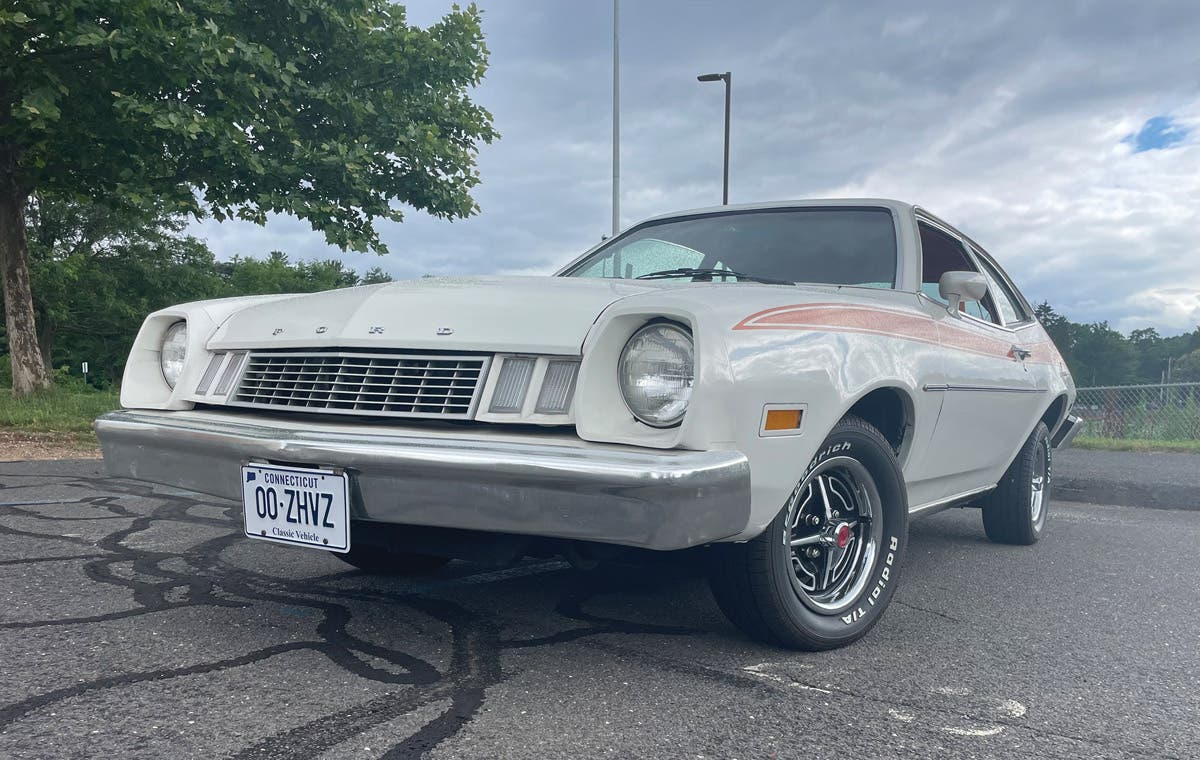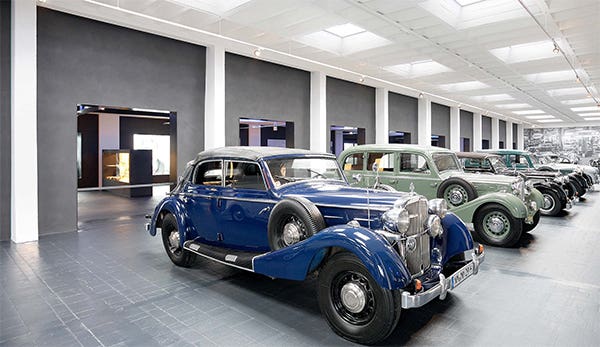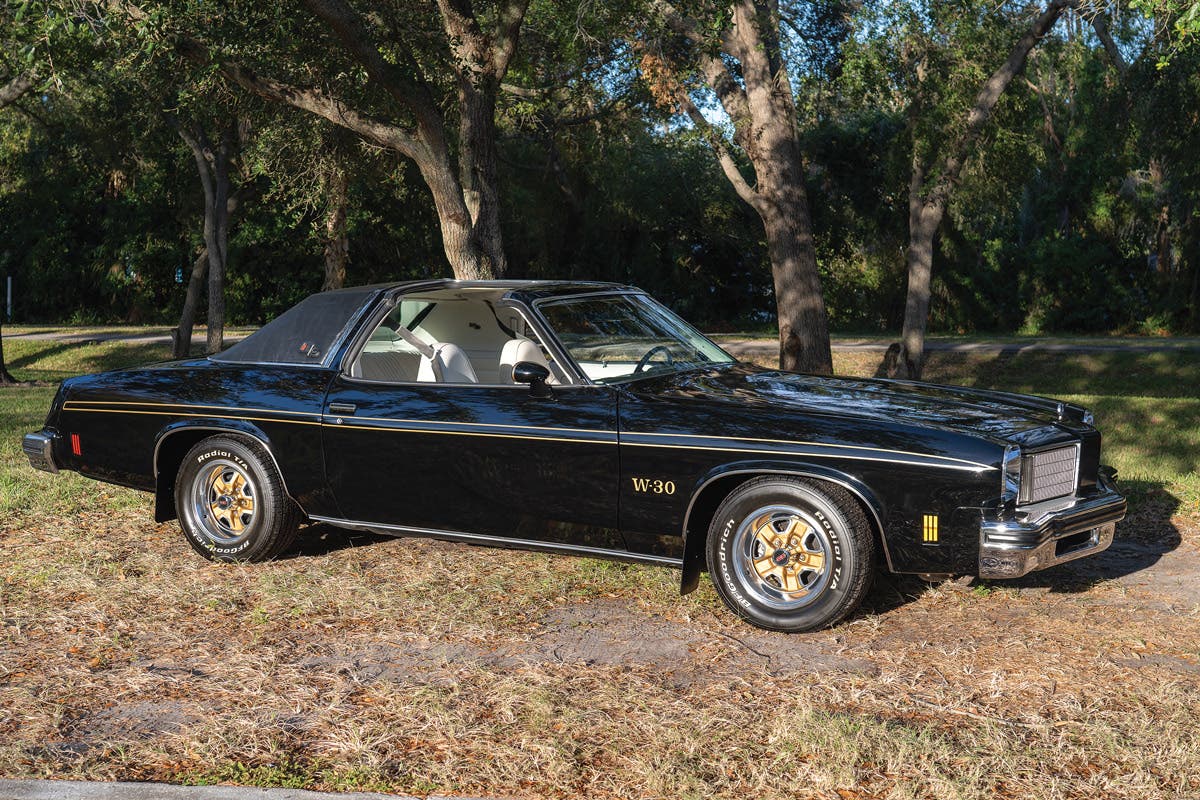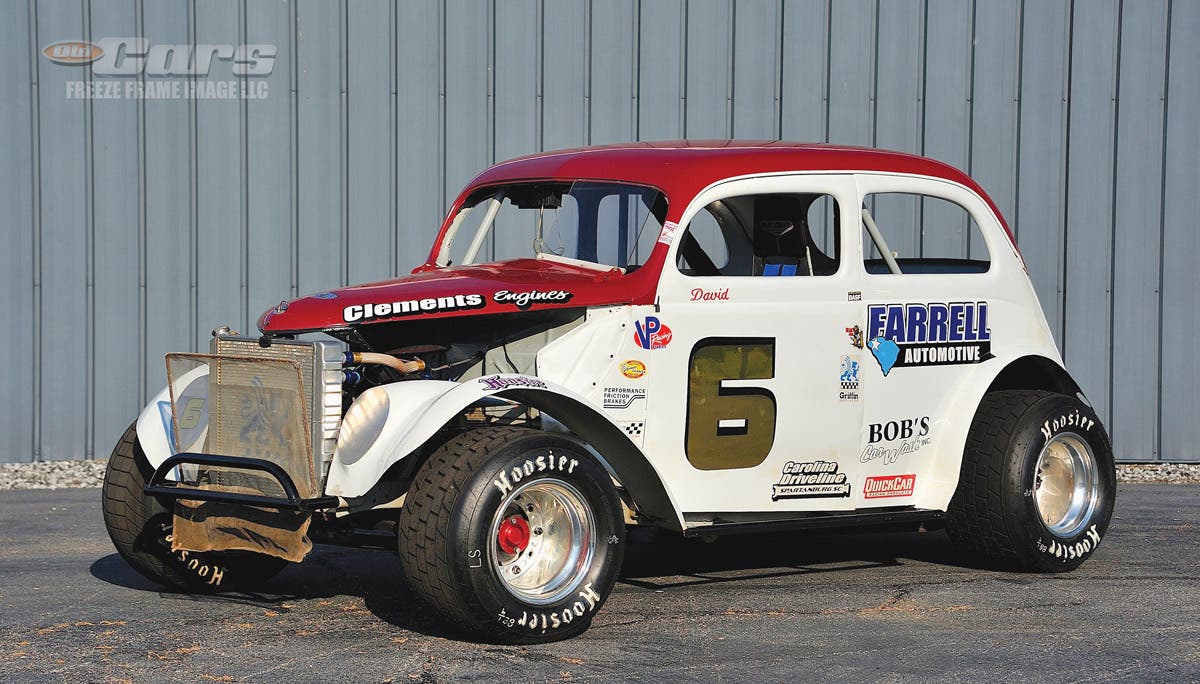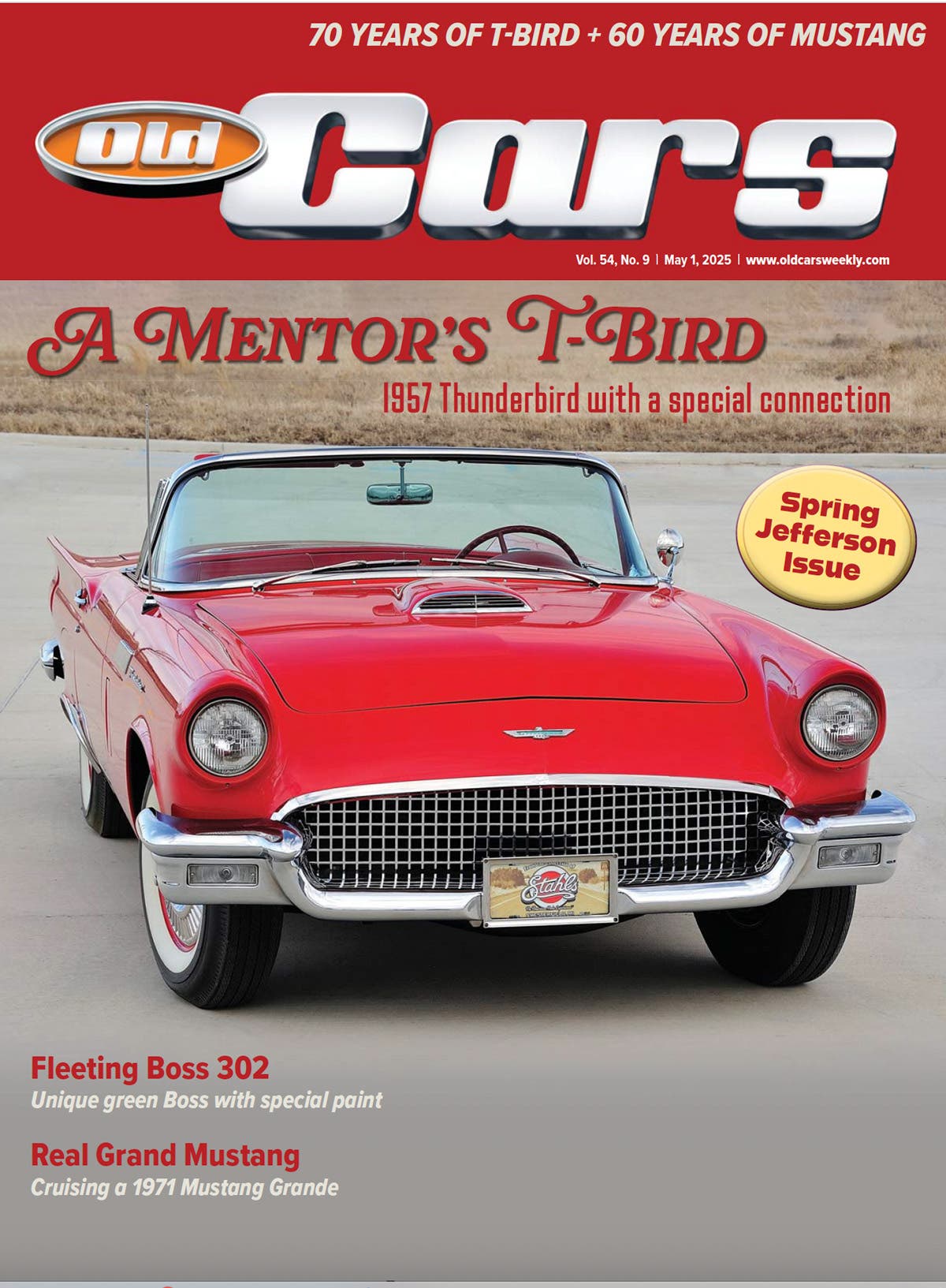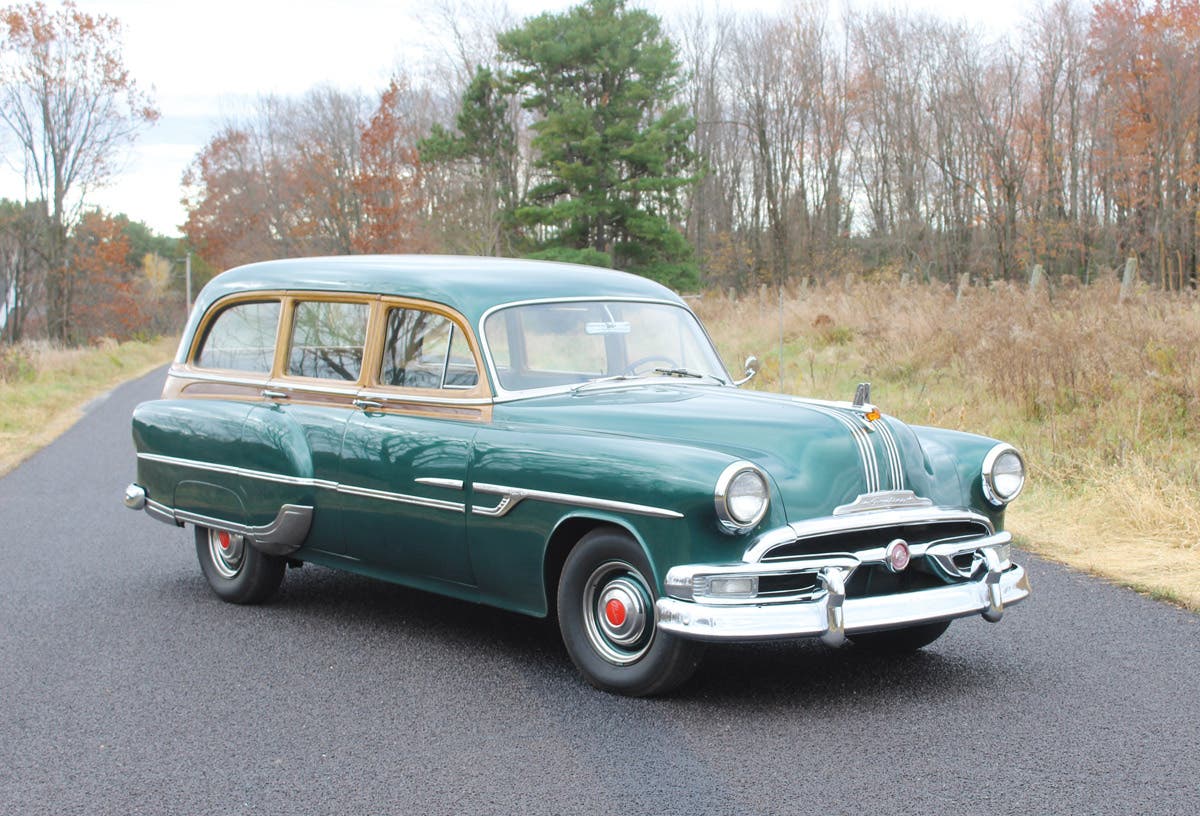Daytona Destiny
A 1959 De Soto’s adventure from assembly line to the starting line.
Bernie Hentges’ 1959 De Soto Firedome, car No. 81, at speed
while qualifying for the 1959 Daytona 500. The Minnesotan
qualified 12th and earned 37th place after driving his race car
to the race.
When most people buy a new car off a dealer’s lot, they use it to fetch groceries, drive to work and carry their family to church. Not Bernie Hentges. When the 22-year-old bought a gleaming new 1959 De Soto, it was with one thing in mind — racing at the newly built Daytona International Speedway.
Racing on the new track, which had replaced the sandy beaches used at Daytona until the new track opened in 1959, wasn’t an honor earned overnight. Hentges had built a strong reputation racing MoPars around his Johnsonville, Minn., home through the 1950s. He had done so well, he caught the attention of Chrysler Corp. officials who even gave him parts and sometimes cars to drive.
“[Chrysler Corp.] had scouts, and if you had a few real good seasons, you would be recognized [with a factory-backed car].
“Wayzata Motors sold me a car ... a D-500,” Hentges said. “About mid year, they came out with the D-500-1. I don’t know if it’s true, but I was told they were only given for racing. I was able to buy it and they gave me all the racing parts for it.
“[The D-500-1] had the Imperial suspension and brakes and was based on the Coronet, the least-expensive model they could put the parts on that there was in 1956.”
While the car was fast enough to maintain Hentges’ growing legend status on Minnesota dirt tracks, it posed several mechanical challenges.
“Every race I was in, I lost an engine,” he said. “I went through eight engines in eleven races.”
From working in his father-in-law’s garage, Hentges was as good under the hood as he was behind the wheel, and it didn’t take him long to determine the source of his engine troubles — motor oil that wasn’t up to the rigors Hentges put it through.
“Every time the engine oil temperature would reach 260 degrees [it would blow],” Hentges said. “Late in the season, I went back to the oil I was using before, Phillips 66 Trop-Arctic, and didn’t blow anymore engines with that oil.”
About this time, Chrysler’s Bert Carter was watching the races at the Minnesota State Fairgrounds and caught Hentges racing one of his company’s cars, the 1956 Dodge D-500-1. Hentges led the race the first 20-30 laps when the predictable happened — the engine blew. Luckily, Hentges was figuring out the source of his engine problems when Carter invited him to Detroit in 1957 to discuss racing MoPars. Hentges arrived with some suggestions.
“I went to Detroit and waited in the office a good three hours before I went to talk to him,” Hentges said. “I told them, ‘the problem I am seeing is you are having lubrication problems.’” Carter told Hentges that the Automotive Manufacturers Association (AMA) had agreed not to sponsor race cars, and that he did not have good enough parts for racing at the time. (However, according to Hentges, General Motors and Ford continued to sponsor race cars.) Hentges left without a sponsor after Carter told him, “We don’t have anything good enough to race for you.”
The 1956 D-500-1 Dodge followed Hentges from Minnesota to his first NASCAR race at Daytona in 1957 where his mechanical luck didn’t get any better.
“It was a two-lane road and I couldn’t pass,” Hentges said of the sandy Daytona track. “If somebody got behind you, they would push. At that time, the cars weren’t as nearly closely matched as they are today, but back then, it was a several-second difference between the cars. I got behind another guy and was pushing him, and then I got pushed. My hood buckled and I was looking through a slot four inches (between the lifted hood and the cowl), and your whole depth of field changes. As we came up the corner, I thought I was closer than we were, but I was going about 110 miles per hour and downshifted and the transmission blew up. It was my own fault.”
In 1958, Hentges kept his racing closer to home and stuck with MoPar products. He acquired a 1958 Plymouth with a 350-cid V-8 and two four-barrel carburetors, but when Hentges raced on the IMCA circuit, he had to install a single carburetor. The Plymouth also received some Imperial suspension components from the D-500-1 Dodge.
“I had pretty good success with it, and if I didn’t wreck it, I finished in the top cars.”
The following year, Hentges received an invitation to run in the Daytona 500 on the new Daytona International Speedway. The honor to drive on the new track was too good to pass up, and even though he was lacking in funds, he bought himself a car and made plans to attend the race.
“When I got the invitation to Daytona in 1959, I knew I wanted a Plymouth or a Dodge with the 383 engine, but there were none available in the five-state area,” Hentges said. He found a beige De Soto Firedome two-door hardtop, which came standard with a 383-cid engine off the showroom floor, but he only had two to three weeks to get it ready and make it to the race. Hentges didn’t fear the deadline, or the repercussions his lack of financing might cause.
“I drove it 14 miles to my [future] father-in-law’s garage, took the upholstery out, the [D-500-1] hubs and spindles off the Plymouth and put them on the De Soto.”
Hentges also removed the front clip to make it easier to access the suspension system and to beef up the chassis.
“There was a box frame on [those De Sotos], and they were only spot welded, so I welded the frame solid,” Hentges said. “I put gussets on all of the corners of the cross member, on the front frame where the stabilizer went across. I changed the A arms and the rest of the Imperial suspension, [and took] off the wheels from my Plymouth and put them on the De Soto.”
The De Soto’s automatic transmission was also removed in favor of the Plymouth manual transmission, and the car was fitted with manual steering. To get all the gauges he needed in one convenient pod, Hentges installed the Plymouth’s instrument cluster on the transmission hump of the De Soto’s floor.
The 383-cid De Soto wedge-head engine received an Isky cam, solid lifters, new push rods and miked head gaskets under CC-ed heads.
Driving the De Soto to Daytona
While the weather in Daytona is nice in February, that’s rarely the case in Minnesota. Hentges expected to tow his De Soto to the Florida race behind a truck, but a snowstorm made the roads slick and Hentges found it impossible to keep the truck and car on the road. After investing so much time and energy into preparing the De Soto for the first race at Daytona International Speedway, Hentges wasn’t about to let some flakes get in his way. He re-installed the headlamps and taillamps into the De Soto and drove the car south with his girlfriend (and future wife) Rita sharing part of the front seat. (That front seat had been pulled from Hentges’ previous Plymouth race car and installed in the De Soto for the race.) Even more shocking to anyone who’s ever driven in a Midwest snow storm, Hentges made the trip on a set of Firestone Super Sports race tires!
“We drove the De Soto down there on the racing tires, which are a real hard compound,” Hentges said, adding the car still had its radio, heater and all the glass to make the long drive somewhat comfortable. To carry the extra parts that would not fit in the De Soto’s trunk, such as an extra pair of tires, the truck was driven behind Hentges’ De Soto.
Before Hentges even left, many of racing’s legends were already at the new track, competing their qualifying runs and tweaking their cars to the new track. On his drive down, Hentges tuned in his radio to hear the reports coming from the track and caught Fireball Roberts’ qualifying time through the De Soto’s speaker. Hentges began to get nervous by the numbers he was hearing.
“I didn’t think I would be able to beat Fireball Roberts,” he said. During the drive to Daytona, Hentges determined a way using his tachometer to figure out if he would be able to get in the 130-mph range the other drivers were running in.
“We got on a highway at one or two in the morning, and I told the drivers [of the truck] to go ahead one mile, and if there isn’t anybody ahead, blink your headlights.”
After the truck traveled ahead one mile and blinked its headlamps, Hentges flogged the De Soto up to speed.
“I calculated how fast I would be going by the rpms in that mile and [determined] I went 135 mph ... I figured I might be able to make it.” When he did make it to the track, Hentges’ qualifying speed was 134 mph.
“That car went pretty doggone good.”
Wide open in a De Soto
Upon emerging from a tunnel onto the track, Hentges was in awe. “The track is enormous, and I had never driven on asphalt,” he said.
Time was running short, so almost immediately, Hentges was instructed to get his physical. Just then, he ran into a couple of racing buddies from Minnesota who didn’t have a car or a way onto the track, so they volunteered to join Hentges’ small pit crew.
“We got in and the first thing they did was pre-race inspection before you got on the track,” he said. “They had to make sure everything you did was to their standards. We did remove one cylinder head to make sure they weren’t milled, and we had to pull out one axle to make sure we didn’t have it locked.”
Then the officials noticed something wrong — the De Soto had tall and skinny tires with deep treads for dirt track racing, not the wider tires appropriate for asphalt.
After a race official waved over the Firestone representative who was on hand, Hentges was able to work out a deal for the right tires that didn’t obliterate his shoestring budget.
“[The Firestone representative] told me the tires were $80 apiece, but was willing to trade for my dirt track tires. He asked me how many miles I had on the tires and said, ‘I’ll trade you.’”
But the rush was on for Hentges to qualify the De Soto for the race, and there was no time for new tires.
“I had just gotten there — everybody else had been there two weeks — and they waved me up to qualify. So I just went ahead on the track.”
And qualify he did. Hentges and the De Soto ran 12th out of a field of 90 cars, 59 of which qualified for the Grand National Event, today called the Sprint Cup. The placement was strong for a finned MoPar with the wrong tires and fresh from a day-long, thousand-mile-plus drive, and with a sleepless driver.
“I had the only new Chrysler in the field,” he said. “Chrysler was not sponsoring. All I had was a number — there was not a [sponsor ’s] sticker on the car. When I came back in the pits, everybody came around me. Fred Lorenzen said, ‘That thing really goes!’ Lee and Richard Petty and track owner Bill France were among the other stars gathered around the De Soto in the garage area.
Once in the race, the De Soto didn’t let him down.
“The [Chrysler Corp.] engines were really good,” Hentges said. “You could twist them as far as you could twist, but the ignition would burn out at 6,200 rpm.
“The car handled really well — I attribute that to the fins... [that made it] handle like an arrow.
“It was quite a different feeling driving that car,” he said. “The fins didn’t make it go faster, but it handled better.”
With a field of legends such as Curtis Turner, Fireball Roberts and the Pettys, the competition was hard and the attrition rate was high.
“A lot of engines blew,” said Hentges, who had his own problems two-thirds of the way through the race.
“At about 350 miles, I stopped and changed the fan belt and went back out,” he said. “It wasn’t very long after that when a valve spring retainer broke. It wasn’t the car’s fault, it was that the valve retainers weren’t made for the Isky cam.”
Hentges and the De Soto finished 37th out of 59 overall (combined Grand National and convertible class), and 26th among his peers in the Grand National class. He even bested Fireball Roberts, whom he feared would be hard to beat, as well as Buck Baker and Richard Petty, who had been anything but friendly to the Yankee from Minnesota.
Departing with the De Soto
Hentges hung around to see the end of the historic 1959 Daytona 500 race, which defined a true “photo finish.”
At the finish line, Lee Petty’s 1959 Oldsmobile SceniCoupe and the 1959 Ford Thunderbird coupe driven by Johnny Beauchamp were nose to nose, but Beauchamp immediately appeared to be the winner and was told to drive to victory lane where he was awarded the win. However, photographic evidence at the finish line made the win questionable, and the results were determined unofficial. About 60 hours after the race ended, photographs taken by several photographers at the finish line proved Petty and his Olds took the checkered flag and Beauchamp and his Thunderbird were actually in second.
When it was time to leave, Hentges built a tow bar to tug the De Soto home. Once home, he worked to get the nearly new De Soto running again so it could be sold. The trip had been on a shoestring budget, and there was little, if any, money left to buy a new powerplant. Luckily, a local dealer had the answer.
“I went to Town and Country Motors in St. Paul and talked to a guy and asked if they had any engines they could sell me,” Hentges said. “They said they didn’t have any they could sell me, but they had a Fireflite engine that kept overheating. He said, ‘We can give you that engine since the factory has already written it off.’ I could not see anything wrong with it, but when I took the freeze plugs out and saw the casting flashing blocking the coolant flow, I knew what the problem was.” With the car running, Hentges said “good-bye.”
“That was a tough thing to do,” Hentges said. “I really wanted to keep it, but I had a business and didn’t have the money to make the payments.
“One guy, a customer, he wanted that car,” Hentges said. “He traded me two ’56 Fords and $500 cash for [the De Soto]. I sold one and kept the other.”
Hentges never drove in another NASCAR race, but he did finish the remainder of the season in a Chrysler at Twin Cities Speedway in Minnesota. After that season in 1959, Hentges did not race again until 1963, which was his last racing season. However, he kept working under the hoods of race-inspired cars.
“I had customers around the Twin Cities who had me tune up their long-ram [manifold] Chrysler engines and put J-2 Oldsmobile engines in Studebaker Golden Hawks for customers” he said.
Today, Hentges operates a small construction firm in California, and although he’s given up cylinder heads and carburetors for nails and two-by-fours, his fondness for racing MoPars still rumbles through 50 years later.
Special thanks to OCW reader Chuck Spiteri and Linda Hentges-Nyman for their help preparing this story.
CLICK HERE to tell us what you think in the Old Cars Weekly forums
Angelo Van Bogart is the editor of Old Cars magazine and wrote the column "Hot Wheels Hunting" for Toy Cars & Models magazine for several years. He has authored several books including "Hot Wheels 40 Years," "Hot Wheels Classics: The Redline Era" and "Cadillac: 100 Years of Innovation." His 2023 book "Inside the Duesenberg SSJ" is his latest. He can be reached at avanbogart@aimmedia.com



